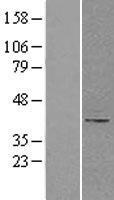B4GALT1 (NM_001497) Human Tagged ORF Clone
CAT#: RC213879
B4GALT1 (Myc-DDK-tagged)-Human UDP-Gal:betaGlcNAc beta 1,4- galactosyltransferase, polypeptide 1 (B4GALT1)
ORF Plasmid: tGFP
"NM_001497" in other vectors (6)
Need custom modification / cloning service?
Get a free quote
CNY 5,488.00
CNY 300.00
Specifications
| Product Data | |
| Type | Human Tagged ORF Clone |
| Tag | Myc-DDK |
| Synonyms | B4GAL-T1; beta4Gal-T1; CDG2D; GGTB2; GT1; GTB |
| Vector | pCMV6-Entry |
| E. coli Selection | Kanamycin (25 ug/mL) |
| Mammalian Cell Selection | Neomycin |
| Sequence Data |
>RC213879 representing NM_001497
Red=Cloning site Blue=ORF Green=Tags(s) TTTTGTAATACGACTCACTATAGGGCGGCCGGGAATTCGTCGACTGGATCCGGTACCGAGGAGATCTGCC GCCGCGATCGCC ATGAGGCTTCGGGAGCCGCTCCTGAGCGGCAGCGCCGCGATGCCAGGCGCGTCCCTACAGCGGGCCTGCC GCCTGCTCGTGGCCGTCTGCGCTCTGCACCTTGGCGTCACCCTCGTTTACTACCTGGCTGGCCGCGACCT GAGCCGCCTGCCCCAACTGGTCGGAGTCTCCACACCGCTGCAGGGCGGCTCGAACAGTGCCGCCGCCATC GGGCAGTCCTCCGGGGAGCTCCGGACCGGAGGGGCCCGGCCGCCGCCTCCTCTAGGCGCCTCCTCCCAGC CGCGCCCGGGTGGCGACTCCAGCCCAGTCGTGGATTCTGGCCCTGGCCCCGCTAGCAACTTGACCTCGGT CCCAGTGCCCCACACCACCGCACTGTCGCTGCCCGCCTGCCCTGAGGAGTCCCCGCTGCTTGTGGGCCCC ATGCTGATTGAGTTTAACATGCCTGTGGACCTGGAGCTCGTGGCAAAGCAGAACCCAAATGTGAAGATGG GCGGCCGCTATGCCCCCAGGGACTGCGTCTCTCCTCACAAGGTGGCCATCATCATTCCATTCCGCAACCG GCAGGAGCACCTCAAGTACTGGCTATATTATTTGCACCCAGTCCTGCAGCGCCAGCAGCTGGACTATGGC ATCTATGTTATCAACCAGGCGGGAGACACTATATTCAATCGTGCTAAGCTCCTCAATGTTGGCTTTCAAG AAGCCTTGAAGGACTATGACTACACCTGCTTTGTGTTTAGTGACGTGGACCTCATTCCAATGAATGACCA TAATGCGTACAGGTGTTTTTCACAGCCACGGCACATTTCCGTTGCAATGGATAAGTTTGGATTCAGCCTA CCTTATGTTCAGTATTTTGGAGGTGTCTCTGCTCTAAGTAAACAACAGTTTCTAACCATCAATGGATTTC CTAATAATTATTGGGGCTGGGGAGGAGAAGATGATGACATTTTTAACAGATTAGTTTTTAGAGGCATGTC TATATCTCGCCCAAATGCTGTGGTCGGGAGGTGTCGCATGATCCGCCACTCAAGAGACAAGAAAAATGAA CCCAATCCTCAGAGGTTTGACCGAATTGCACACACAAAGGAGACAATGCTCTCTGATGGTTTGAACTCAC TCACCTACCAGGTGCTGGATGTACAGAGATACCCATTGTATACCCAAATCACAGTGGACATCGGGACACC GAGC ACGCGTACGCGGCCGCTCGAGCAGAAACTCATCTCAGAAGAGGATCTGGCAGCAAATGATATCCTGGATT ACAAGGATGACGACGATAAGGTTTAA >RC213879 representing NM_001497
Red=Cloning site Green=Tags(s) MRLREPLLSGSAAMPGASLQRACRLLVAVCALHLGVTLVYYLAGRDLSRLPQLVGVSTPLQGGSNSAAAI GQSSGELRTGGARPPPPLGASSQPRPGGDSSPVVDSGPGPASNLTSVPVPHTTALSLPACPEESPLLVGP MLIEFNMPVDLELVAKQNPNVKMGGRYAPRDCVSPHKVAIIIPFRNRQEHLKYWLYYLHPVLQRQQLDYG IYVINQAGDTIFNRAKLLNVGFQEALKDYDYTCFVFSDVDLIPMNDHNAYRCFSQPRHISVAMDKFGFSL PYVQYFGGVSALSKQQFLTINGFPNNYWGWGGEDDDIFNRLVFRGMSISRPNAVVGRCRMIRHSRDKKNE PNPQRFDRIAHTKETMLSDGLNSLTYQVLDVQRYPLYTQITVDIGTPS TRTRPLEQKLISEEDLAANDILDYKDDDDKV |
| Chromatograms |
CHROMATOGRAMS
 Sequencher program is needed, download here. |
| Restriction Sites |
SgfI-MluI
Cloning Scheme for this gene
Plasmid Map

|
| ACCN | NM_001497 |
| ORF Size | 1194 bp |
| OTI Disclaimer | Due to the inherent nature of this plasmid, standard methods to replicate additional amounts of DNA in E. coli are highly likely to result in mutations and/or rearrangements. Therefore, OriGene does not guarantee the capability to replicate this plasmid DNA. Additional amounts of DNA can be purchased from OriGene with batch-specific, full-sequence verification at a reduced cost. Please contact our customer care team at custsupport@origene.com or by calling 301.340.3188 option 3 for pricing and delivery. The molecular sequence of this clone aligns with the gene accession number as a point of reference only. However, individual transcript sequences of the same gene can differ through naturally occurring variations (e.g. polymorphisms), each with its own valid existence. This clone is substantially in agreement with the reference, but a complete review of all prevailing variants is recommended prior to use. More info |
| OTI Annotation | This clone was engineered to express the complete ORF with an expression tag. Expression varies depending on the nature of the gene. |
| Product Components | The ORF clone is ion-exchange column purified and shipped in a 2D barcoded Matrix tube containing 10ug of transfection-ready, dried plasmid DNA (reconstitute with 100 ul of water). |
| Reconstitution | 1. Centrifuge at 5,000xg for 5min. 2. Carefully open the tube and add 100ul of sterile water to dissolve the DNA. 3. Close the tube and incubate for 10 minutes at room temperature. 4. Briefly vortex the tube and then do a quick spin (less than 5000xg) to concentrate the liquid at the bottom. 5. Store the suspended plasmid at -20°C. The DNA is stable for at least one year from date of shipping when stored at -20°C. |
| Reference Data | |
| RefSeq | NM_001497.4 |
| RefSeq Size | 4080 bp |
| RefSeq ORF | 1197 bp |
| Locus ID | 2683 |
| UniProt ID | P15291 |
| Domains | Galactosyl_T_2 |
| Protein Families | Druggable Genome, Transmembrane |
| Protein Pathways | Galactose metabolism, Glycosphingolipid biosynthesis - lacto and neolacto series, Keratan sulfate biosynthesis, Metabolic pathways, N-Glycan biosynthesis |
| MW | 43.7 kDa |
| Gene Summary | This gene is one of seven beta-1,4-galactosyltransferase (beta4GalT) genes. They encode type II membrane-bound glycoproteins that appear to have exclusive specificity for the donor substrate UDP-galactose; all transfer galactose in a beta1,4 linkage to similar acceptor sugars: GlcNAc, Glc, and Xyl. Each beta4GalT has a distinct function in the biosynthesis of different glycoconjugates and saccharide structures. As type II membrane proteins, they have an N-terminal hydrophobic signal sequence that directs the protein to the Golgi apparatus and which then remains uncleaved to function as a transmembrane anchor. By sequence similarity, the beta4GalTs form four groups: beta4GalT1 and beta4GalT2, beta4GalT3 and beta4GalT4, beta4GalT5 and beta4GalT6, and beta4GalT7. This gene is unique among the beta4GalT genes because it encodes an enzyme that participates both in glycoconjugate and lactose biosynthesis. For the first activity, the enzyme adds galactose to N-acetylglucosamine residues that are either monosaccharides or the nonreducing ends of glycoprotein carbohydrate chains. The second activity is restricted to lactating mammary tissues where the enzyme forms a heterodimer with alpha-lactalbumin to catalyze UDP-galactose + D-glucose <=> UDP + lactose. The two enzymatic forms result from alternate transcription initiation sites and post-translational processing. Two transcripts, which differ only at the 5' end, with approximate lengths of 4.1 kb and 3.9 kb encode the same protein. The longer transcript encodes the type II membrane-bound, trans-Golgi resident protein involved in glycoconjugate biosynthesis. The shorter transcript encodes a protein which is cleaved to form the soluble lactose synthase. [provided by RefSeq, Jul 2008] |
Documents
| Product Manuals |
| FAQs |
| SDS |
Resources
Other Versions
| SKU | Description | Size | Price |
|---|---|---|---|
| RC213879L1 | Lenti ORF clone of Human UDP-Gal:betaGlcNAc beta 1,4- galactosyltransferase, polypeptide 1 (B4GALT1), Myc-DDK-tagged |
CNY 7,888.00 |
|
| RC213879L2 | Lenti ORF clone of Human UDP-Gal:betaGlcNAc beta 1,4- galactosyltransferase, polypeptide 1 (B4GALT1), mGFP tagged |
CNY 7,888.00 |
|
| RC213879L3 | Lenti ORF clone of Human UDP-Gal:betaGlcNAc beta 1,4- galactosyltransferase, polypeptide 1 (B4GALT1), Myc-DDK-tagged |
CNY 7,888.00 |
|
| RC213879L4 | Lenti ORF clone of Human UDP-Gal:betaGlcNAc beta 1,4- galactosyltransferase, polypeptide 1 (B4GALT1), mGFP tagged |
CNY 7,888.00 |
|
| RG213879 | B4GALT1 (tGFP-tagged) - Human UDP-Gal:betaGlcNAc beta 1,4- galactosyltransferase, polypeptide 1 (B4GALT1) |
CNY 7,088.00 |
|
| SC119205 | B4GALT1 (untagged)-Human UDP-Gal:betaGlcNAc beta 1,4- galactosyltransferase, polypeptide 1 (B4GALT1) |
CNY 3,656.00 |
其它B4GALT1产品


 United States
United States
 Germany
Germany
 Japan
Japan
 United Kingdom
United Kingdom
 China
China



